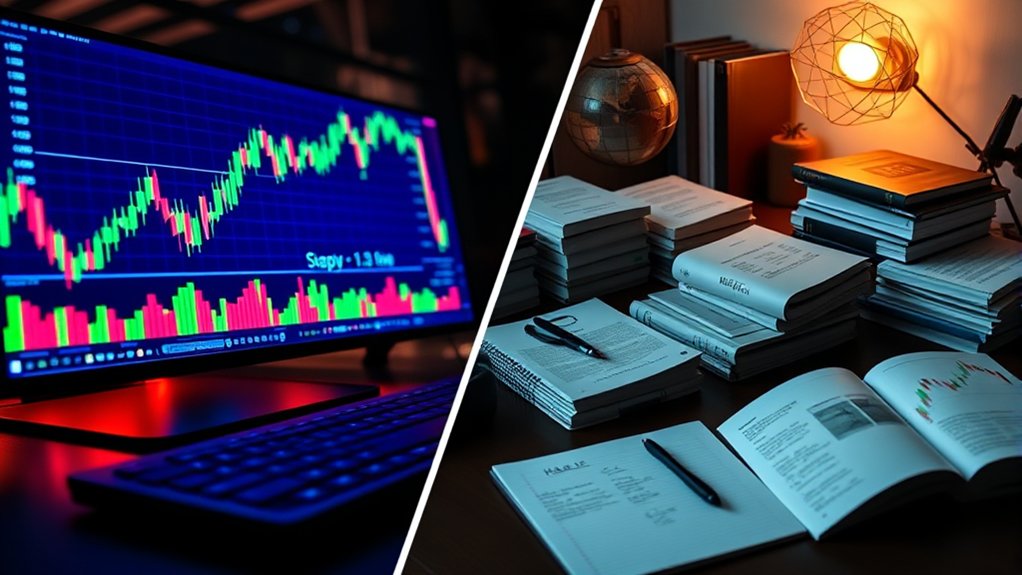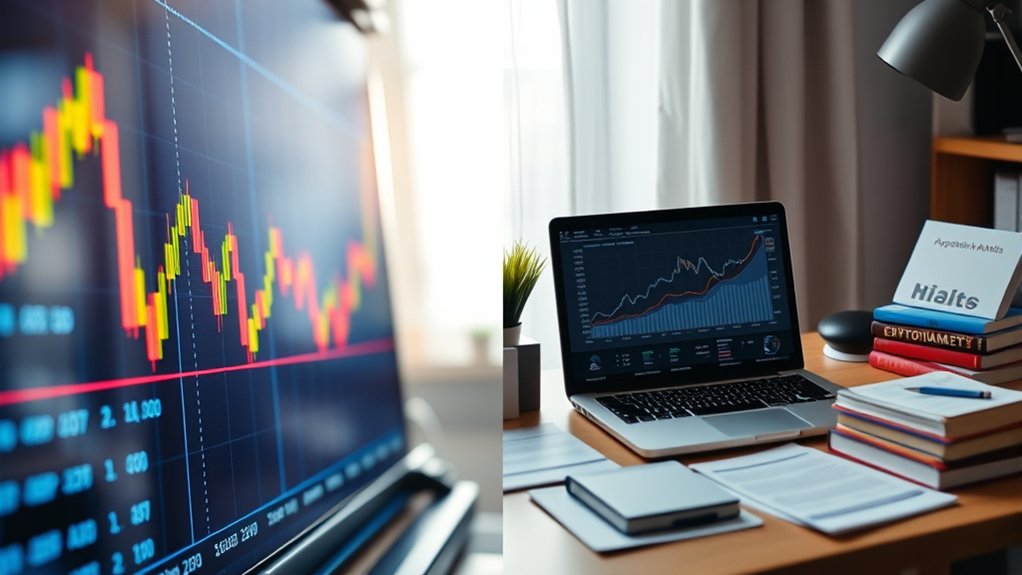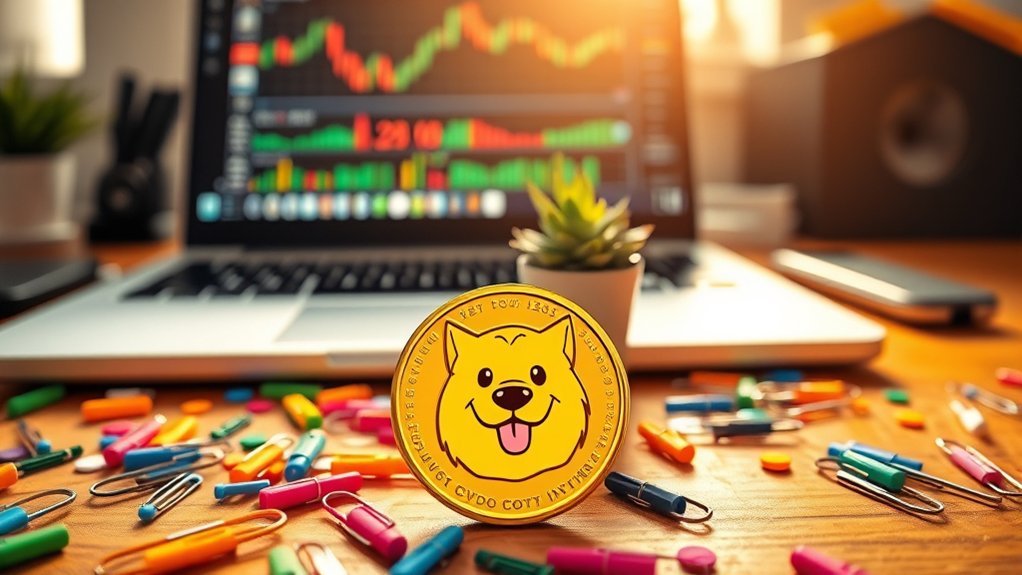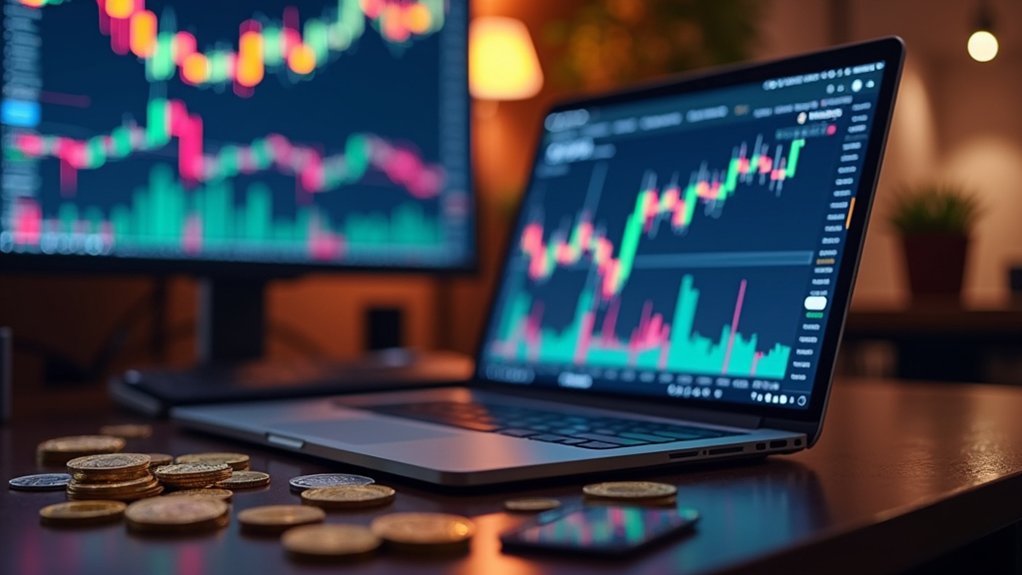In crypto trading, technical analysis looks at charts, numbers, and patterns. It’s all about predicting future moves using historical data. But it’s risky. Trends can vanish faster than morning coffee. On the other hand, fundamental analysis digs into what makes a cryptocurrency tick—like its market cap and the team behind it. It’s great for long-term investors who like to play it safe. Both methods have their pros and cons. Stick around, there’s plenty more to explore.

What’s the secret sauce behind successful crypto trading? It’s a chaotic mix of technical and fundamental analysis, and let’s be real, figuring this out is like trying to decipher a toddler’s crayon drawing.
On one side, you have technical analysis. This is all about the numbers and patterns. Traders look at historical data, hoping it’ll predict future price movements. Sounds simple, right? Well, they use fancy tools like moving averages and Bollinger Bands. These gadgets help them evaluate market sentiment, but here’s the kicker: it’s risky. Just because a pattern happened before doesn’t mean it’ll happen again. Successful traders utilize a combination of technical analysis and other methods to navigate the complexities of the market. Statistical analysis is a cornerstone of this approach. Additionally, many traders also consider market capitalization to gauge the overall health of a cryptocurrency.
Then, there’s fundamental analysis, the “let’s look at the bigger picture” approach. It dives into the soul of a cryptocurrency, examining its utility, the brains behind it, and market cap. This method is like checking the ingredients before eating a mystery meat sandwich. It tells you whether an asset is truly worth its price tag. Great for long-term strategies, but also prone to missing out on those immediate market feels. So, if you’re looking to hold for the long haul, fundamental analysis might be your buddy.
The key indicators for technical analysis are like a Swiss Army knife, but they can only handle short-term situations. Moving averages? They smooth out the chaos. RSI? It shows if things are too hot or too cold.
On the flip side, fundamental analysis relies on stuff like market cap and adoption rate. It’s all about evaluating what’s really happening beneath the surface.
Sure, technical analysis is for the day traders, the adrenaline junkies. Fundamental analysis? That’s for the cautious investors, the tortoises in a world of hares. Each has its perks and pitfalls, but the real magic? It’s knowing when to use each tool. Because in crypto, you never know what’s coming next.
Frequently Asked Questions
What Are the Best Tools for Technical Analysis in Crypto Trading?
When it comes to technical analysis in crypto trading, several tools stand out.
TradingView? A must-have for its killer charting capabilities.
Coinigy? Perfect for those who want to juggle multiple exchanges like a circus performer.
CryptoCompare keeps you updated in real-time, while CoinMarketCap is your go-to for basic price checks.
ChartIQ? Designed for pros who like their charts fancy and customizable.
Get ready to dive deep into the market madness!
How Do News Events Impact Fundamental Analysis in Crypto?
News events shake up the crypto world like a snow globe. They can change how people feel about a coin overnight.
Regulatory updates? Boom—suddenly, investors are sweating bullets. New tech? Great! Everyone’s excited again.
Economic data? That might just tank the mood. And let’s not forget social media, where rumors spread faster than wildfire.
Can I Use Both Analyses Simultaneously for Better Results?
Absolutely, using both analyses together is like having your cake and eating it too. It’s smart!
You get the long-term vision from one and the short-term insights from the other. The magic happens when they sync up—like the universe aligning.
Sure, it takes some effort, but hey, that’s the game, right? A well-rounded approach can reduce risks and boost confidence. Who wouldn’t want that?
What Timeframes Are Best for Technical Analysis in Crypto?
When it comes to technical analysis in crypto, timeframes matter.
For scalpers, 1-minute and 5-minute charts are the bread and butter—blink and you might miss it.
Day traders? They stick to 15-minute charts, juggling trends like pros.
Swing traders lean towards 30-minute to hourly charts, smoothing out the chaos.
Long-term traders? They cozy up with 4-hour to daily charts, taking their sweet time.
It’s all about finding the rhythm that matches the madness.
How Do I Choose Between Technical and Fundamental Analysis?
Choosing between analysis methods is like picking a favorite child. It depends on what you’re after.
Want quick gains? Go with the trends and patterns—short-term thrills.
But if you’re dreaming long-term, dive deep into value and growth potential.
Market conditions? They don’t care about your plans. Use that to your advantage.
If you’re confused, don’t worry. Many are. Just remember: the right choice is the one that fits your style.





